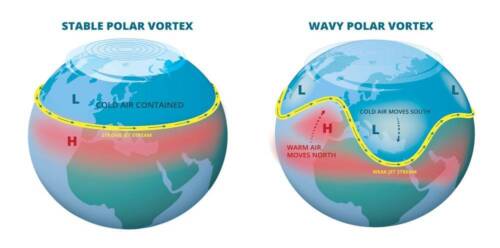What’s a Polar Vortex and What are it’s Impacts?
As winter approaches, meteorologists and climate scientists are closely monitoring the activity of the polar vortex over the North Pole to determine how it will influence the weather patterns of the northern hemisphere. The polar vortex, a complex and dynamic atmospheric phenomenon, has captured the attention of not only scientists but also business leaders due to its far-reaching effects on weather patterns, particularly in North America. In this blog post, we will delve into what the polar vortex is, why meteorologists care about it, its influence on winter season outlooks, how it will be impacted by the emerging El Niño for the Winter 2023/2024 season, and why business leaders should take note of its implications.
Understanding the Polar Vortex
The polar vortex is a large area of low pressure and bitter cold air, moving in a counterclockwise direction that occurs at each of earth’s poles. This frigid air mass is trapped by strong westerly winds known as the polar jet stream. The vortex can extend downward into the troposphere, the layer of the atmosphere where our weather occurs, influencing the weather patterns we experience on the surface.

Why Meteorologists Care
Meteorologists closely monitor the polar vortex because it plays a pivotal role in shaping weather patterns across the Northern Hemisphere. Changes in the strength and position of the vortex can lead to significant weather anomalies, including extreme cold outbreaks, winter storms, and shifts in the jet stream. Understanding and predicting these changes are critical for weather forecasting and climate research.
Impacts on Winter Season Outlooks
The polar vortex has a profound impact on the winter season outlook for areas like North America, Europe and Asia. When the vortex is strong and stable, it helps keep frigid Arctic air locked in the polar regions, resulting in milder winters for many parts of the United States and Canada. Conversely, a weakened or disrupted polar vortex can allow Arctic air to spill southward, leading to colder and more volatile winter conditions.

El Niño’s Influence on the Polar Vortex
One crucial factor to consider in the upcoming 2023/2024 winter season is the influence of El Niño. El Niño is a climate phenomenon characterized by warmer-than-average sea surface temperatures in the tropical Pacific Ocean. If you’d like to read more about El Niño, read our blog post: El Niño Demystified: Insights into Its Impacts and Mitigation. While El Niño primarily affects tropical and subtropical regions, its influence can propagate across the globe and have significant influences on the polar vortex and the 2023/2024 winter season in North America. Here’s how El Niño may impact the polar vortex and the ensuing winter conditions:
Weakening of the Polar Vortex
During an El Niño event, changes in the Pacific Ocean’s temperature can lead to alterations in atmospheric circulation patterns. One of the potential outcomes is a weakening of the polar vortex. This weakening can be associated with a more meridional (north-south) jet stream, allowing frigid Arctic air to penetrate farther southward into North America.
Increased Likelihood of Cold Outbreaks
When the polar vortex weakens, it becomes more susceptible to disruptions, which can lead to the displacement of cold Arctic air masses. This can result in increased chances of cold outbreaks in regions typically less affected by extreme winter conditions. For example, areas in the southern United States that are not accustomed to prolonged periods of cold weather may experience more frequent and severe winter events.
Precipitation Patterns
El Niño can also influence precipitation patterns across North America. While its impacts on specific regions can vary, some areas may experience increased rainfall and snowfall during an El Niño event. The combination of colder temperatures from a weakened polar vortex and increased moisture can lead to heavier snowfall and potentially more winter storms in affected areas.
Temperature Variability
El Niño’s effects on the polar vortex can introduce temperature variability. In some regions, this may lead to milder and wetter conditions, while in others, it can result in colder and drier conditions. Businesses, especially those in the retail, transportation, and agriculture sectors, should be prepared for these fluctuations, as they can influence consumer behavior, supply chain management, and crop yields.
Impact on Energy Demand
A more variable and potentially colder winter brought about by El Niño-influenced polar vortex patterns can impact energy demand. Businesses in the energy and utilities sector need to be prepared for potential shifts in energy consumption and supply during these conditions.
It’s important to note that while El Niño can provide valuable information about the broader atmospheric patterns, its influence on specific regions can be complex and variable. The strength and duration of El Niño, as well as other atmospheric factors, will play a role in shaping the 2023/2024 winter season weather.
Why Business Leaders Should Care
The polar vortex’s impact on North American winters carries significant implications for various industries. Here’s why business leaders should take notice:
- Energy and Utilities: Colder winters can lead to increased energy demand for heating, potentially affecting energy prices and supply stability. Businesses in the energy sector must prepare for fluctuations in energy demand.
- Agriculture: The timing and severity of cold outbreaks can affect crop yields and production, impacting the agricultural sector. Businesses involved in farming and food production must adapt to these changes.
- Transportation and Logistics: Severe winter weather can disrupt transportation networks and logistics operations, potentially leading to delays and increased costs for businesses reliant on timely deliveries.
- Insurance: Insurance companies must factor in the increased risk of winter-related claims during colder winters, affecting premiums and risk assessment.
Harness Accurate Weather Insights for Winter Weather Events
The polar vortex is a meteorological phenomenon with potentially severe implications. Its influence on winter weather patterns in North America and its interactions with El Niño have significant implications for various industries. Business leaders need to be proactive in understanding and preparing for the potential impacts of the polar vortex on their operations, as it can influence everything from energy costs to consumer behavior. Phenomena like the polar vortex highlight the need to stay informed with the latest advancements in weather technology. As we approach winter for the 2023/2024 season, staying informed about the weather events is essential for making informed decisions and ensuring business resilience in the face of variable winter conditions. If you’d like to learn how Climavision’s investments in weather technology advancements can provide you better winter weather event insights, contact us.




